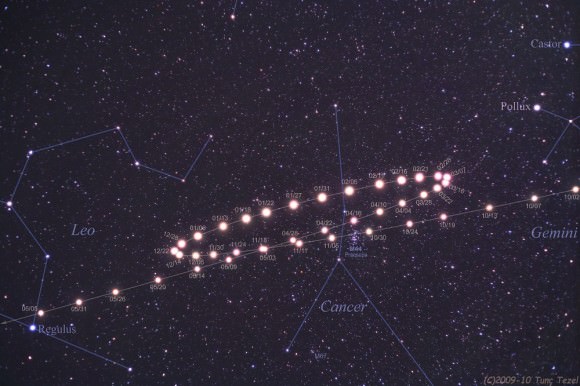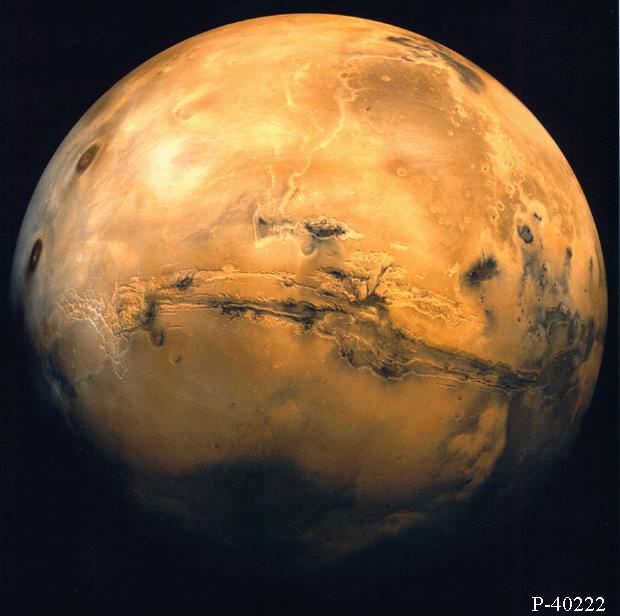Given it’s similarities to Earth, Mars is often referred to as “Earth’s Twin”. Like Earth, Mars is a terrestrial planet, which means it is composed largely of silicate rock and minerals that are differentiated into a core, mantle and crust. It is also located within the Sun’s “Goldilocks Zone” (aka. habitable zone), has polar ice caps, and once had flowing water on its surface. But beyond these, Mars and Earth are very different worlds.
In addition to their stark contrasts in temperature, surface conditions, and exposure to harmful radiation, Mars also takes a significantly longer time to complete a single orbit of the Sun. In fact, a year on Mars is almost twice as long as a year here on Earth – lasting 686.971 days, which works out to about 1.88 Earth years. And in the course of that orbit, the planet undergoes some rather interesting changes.
Interestingly enough, what Mars goes through in the course of a Martian year is quite similar to what Earth goes through (yet another thing they have in common). Depending on its distance from the Sun, and which hemisphere is pointed towards it, changes in temperatures and weather occur in one hemisphere or the other. In short, Mars experiences seasonal changes, like Earth, thanks to the tilt of the planet’s axis and the eccentricity of its orbit.
Orbital Eccentricity:
Mars orbits our Sun at an average distance (semi-major axis) of 227,939,200 km, which is roughly 1.5 times the distance between the Sun and Earth (1.523679 AU). However, during the course of its 686.971 day orbital period, its distance from the Sun changes considerably. During the course of a Martian year, the planet’s orbit ranges in distance from 206,700,000 km (1.3814 AU) at perihelion to 249,200,000 km (1.666 AU) at aphelion.

This amounts to an orbital eccentricity of about 0.09, which is more pronounced than any other planet in the Solar System ( except for Mercury which has an eccentricity of 0.20563). However, it is understood that this was not always the case. In fact, roughly 1.35 million years ago, Mars’ orbit was nearly circular, with an eccentricity of just 0.002.
What’s more, for the past 35,000 years, the orbit of Mars has been getting slightly more eccentric because of the gravitational effects of the other planets. It reached a minimum eccentricity of 0.079 some 19,000 years ago, and will peak at about 0.105 in about 24,000 years from now. In 1,000,000 years from now, its eccentricity will be close to what it is now again – with an estimated eccentricity of 0.01.
Every 780 days (779.94 to be precise), Earth and Mars achieve their closest distance. This occurs roughly 8.5 days after Mars reaches opposition, when there is a 180° difference between the geocentric longitudes of it and the Sun and the Earth passes between them. This is the closest Mars ever gets to Earth, at a distance of about 56 million km, making it the ideal time for sending exploration missions (which would take 8 months to arrive, rather than several years).
A sidereal day, the amount of time it takes for Mars to complete a single rotation on its axis, is roughly 24 hours, 37 minutes, and 22 seconds. Meanwhile, a solar day (or Sol) on Mars – i.e. the amount of time it takes for the Sun to return to the same place in the sky – lasts 24 hours, 39 minutes, and 35.244 seconds. As such, a Martian year is equivalent to 668.5991 Sols.

Seasonal Changes:
Mars’ axis is titled at 25.19 degrees relative to its orbital plane, which is similar to the axial tilt of Earth (23.44 degrees). As a result, Mars has seasons like Earth. Except that on Mars, they are nearly twice as long because its orbital period is that much longer. In the northern hemisphere, spring is the longest season, lasting roughly 7 Earth months out of the year. Summer is second, lasting six months, while Fall lasts 5.3 months and Winter is just over 4 months. In the south, the length of the seasons is only slightly different.
Mars’ orbital eccentricity is also a major factor when it comes to the planet’s seasonal cycles. It is near perihelion when it is summer in the southern hemisphere and winter in the north, and near aphelion when it is winter in the southern hemisphere and summer in the north. As a result, the seasons in the southern hemisphere are more extreme and the seasons in the northern are milder. The summer temperatures in the south can be up to 30 K (30 °C; 54 °F) warmer than the equivalent summer temperatures in the north.
Mars also has the largest dust storms in the Solar System. These can vary from a storm over a small area, to gigantic storms (thousands of km in diameter) that cover the entire planet and obscure the surface from view. They tend to occur when Mars is closest to the Sun, and have been shown to increase the global temperature.

The planet’s average temperature is -46 °C (-51 °F), with a low of -143 °C (-225.4 °F) during the winter at the poles, and a high of 35 °C (95 °F) during summer and midday at the equator. This works out to a variation in average surface temperature that is quite similar to Earth’s – a difference of 178 °C (320.4 °F) versus 145.9 °C (262.5 °F).
All told, Mars has a lot in common with Earth. At the same time, it has several key differences. Knowing what these are and how to address them will be crucial when it comes time to mount crewed missions to Mars, not to mention building permanent settlements there.
We have written many interesting articles about Mars here at Universe Today. Here’s How Strong Is The Gravity On Mars?, How Long Does It Take To Get To Mars?, How Long Is A Day On Mars?, Mars Compared To Earth, How Can We Live On Mars?
Astronomy Cast also has several good episodes on the subject – Episode 52: Mars, Episode 92: Missions to Mars – Part 1, and Episode 94: Humans to Mars, Part 1 – Scientists.
For more information, check out NASA’s Solar System Exploration page on Mars and NASA’s Journey to Mars.


Given it’s similarities to Earth, Mars is often referred to as “Earth’s Twin”. [citation needed]
In all seriousness, I think you have Mars confused with Venus on that moniker.
Since our solar system contains 3 planets within the system (Venus, Earth & Mars) that would / could be sonsidered within the ‘habitable zone’ of a solar system, it makes we wonder if there is some ‘species’ out there in the galaxy somewhere that might be looking around (like we are doing) and seeing 3 planets in a habitable zone, might want to make them ‘look a little closer’ at our home system
30 C not equal 54 F . Add 32.
Martin, its a change (delta) of 30 degrees C that the sentence is referring to, not the temperature 30 degrees C. For example going from 0 to 30 degrees C, is the same as going from 32 to 86 degrees F, which is a difference of 54 degrees F.
Amazing!